Bondage: A Personal Overview of the James Bond Films
"Bond, James Bond..." - James Bond
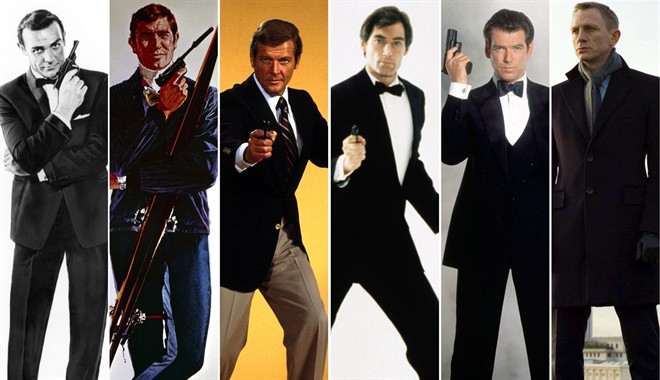

At the time of writing, it’s late June. Back in early January, I decided it was time to go through all the official James Bond films in their release order. So, every Saturday evening for the past 25 weeks, I’ve cracked open the box set, inserted the appropriate Bluray disc in the player and settled down to enjoy a series of films I’ve been a fan of since my eighth year.
That’s a long time to be a fan of anything. I think that for me, only Batman has lasted longer. Somewhere along the line, it began to dawn on me that somewhere in the middle of all the nostalgia of childhood screenings in the Palladium, a fond look back and seeing how my attitudes towards the series have changed in some instances might make an interesting writing exercise. And this is that exercise. So, cue the staccato beat and the row of white dots entering the black screen from the right, as a man in a tuxedo walks into the shot, turns and shoots.
We’ve established that I’ve re-watched all 25 Bond films, 60 years’ worth, from Sean Connery’s first to Daniel Craig’s last. These were the official films, so there’s no David Niven in Casino Royale, nor Sean Connery’s Never Say Never Again. (I’ve only seen the original Casino Royale once, decades ago and it didn’t make an impression. Never Say Never again was a thin remake of Thunderball.)
The Connery Era 1962 – 1971
Doctor No was an important movie, setting the standard and establishing the tropes that would become endlessly repeated and parodied. The suave English gentleman secret agent (though Connery was Scottish, Lazenby was Australian, Dalton was Welsh and Brosnan was Irish). Bond is cool, unflappable, exquisite taste in clothing, cars, food. But let’s face it – he’s got to be the world’s worst “secret” agent because it seems everybody knows his name and recognises him on sight. (Just saying.) He also seems to have a limitless expense account, costing the taxpayer a fortune. He always travels first class, always stays in the best suites in the most expensive and exclusive hotels. From what we see of his gambling activities in various casinos – he must also be a multi-millionaire.
We start off well in establishing the mood. Bond is dispatched to Jamaica to investigate the murder of a fellow agent and his secretary, and the toppling of rockets – sabotage by interfering with their guidance systems. It’s all happening at Crab Key, the island stronghold of Doctor No (Joseph Wiseman). Doctor No was the first Bond villain and established a long tradition of having some kind of physical distinction – in this case, he had lost both hands, and now had black metal ones.
It also established a pretty rigid formula of the brief flirtation scene with Miss Moneypenny (Lois Maxwell) the mission briefing by grumbling spymaster M (Bernard Lee) and the issuing of Bond’s equipment by Q. Then, it’s glamorous locations, car chases, the sacrificial lamb and the spectacular explosion of the villain’s exotic lair at the end before Bond had his final pre-credit scene with the leading lady in his arms. Word of explanation - sacrificial lamb? Bond will have an ally or an associate who will lose their lives, usually before the halfway mark of the film. (In Doctor No, it’s his Jamaican contact, Quarrel who dies in the third quarter.)
Looking at the film from a sixties sensibility, its central character was in tune with the times, I guess but some scenes make for uncomfortable viewing watched 61 years later – most notably the way Bond barks orders at Quarrel. There’s an element of Imperialism and racism around the way the character is portrayed here, and of course the misogynistic attitude is off the scale, and would be for several more films. (In the trailer for the second film, From Russia, With Love, Bond is referenced as “Women want him, men want to BE him”)
From Russia, With Love seemed to be kind of a step backward from Doctor No. The science fiction elements of remotely sabotaging the space race were dropped in favour of a pretty standard cold war thriller with Bond being set up for a humiliating death having been filmed having sex with a Russian operative with the lure of a Russian decoding machine to set the trap. The real standouts in the film are Lotte Lenya as Rosa Klebb, a fanatical Russian operative who kills with a swift kick to the shin with a retractable spike in her shoe, poisoned of course. With her is Red Grant, a muscular thug played by Robert Shaw, who’d find even greater fame 12 years later as Quint in Steven Spielberg’s Jaws. These are the first of the deformed/enhanced henchmen, of whom there’d be a virtual catalogue over the years. (Basically, in a Bond movie, if you’re disabled – you’re a villain.)
Both of these films are just introductions, really. The Bond series were gaining traction and making plenty of money, Connery was becoming a superstar. The magic REALLY happened with Goldfinger.
Goldfinger is where the Bond formula became fully locked down and is THE essential Bond movie. From the performance of the theme song by Shirley Bassey to the final credit, it’s the most easily recognisable of all of them, and if I was asked which Bond film should I watch to see everything I need to know about the character, then clearly the answer has to be Goldfinger, which I believe to be the best representation of the entire series. Connery finally seems to be fully at ease with his character, which gives rise to my long held and fully tried and proven Bond Rule of Three.
My Bond Rule of Three states that it takes three movies for an actor to fully settle into the role, and the third outing tends to be the best. The films in question speak for themselves. For Connery it was Goldfinger, Moore had The Spy Who Loved Me, Brosnan’s was The World is not Enough and Craig had Skyfall. Point proven. It’s a colossal shame that Dalton never got his third.
Back to Goldfinger, we’re right on track with German actor Gert Frobe playing a megalomaniac nutjob named Auric Goldfinger’s plot to nuke America’s gold reserves to boost the value of his own stock. He has a Korean butler/valet/henchman named Oddjob played by wrestler Harold Sakata, and of course this introduces the first and ultimate Bond gadget, the Aston Martin DB5, kitted out like an urban assault vehicle with machine guns, ejector seat, smoke screen, bullet proof glass and a whole range of other lethal goodies.
It also introduced us to perhaps the ultimate Bond girl in Honor Blackman, as the outrageously named Pussy Galore and the ultimate sacrificial lamb visual with Shirley Eaton covered head to toe in gold paint.
The formula was established – there was only one way to go, as the sixties spy craze took off – and that was to make everything bigger. Thunderball re-established the SPECTRE organisation mentioned in both Dr No and From Russia, With Love. (Note of trivia, SPECTRE was an acronym for Special Executive for Counter Terrorism and the Removal of Undesirables.) SPECTRE, represented here by Largo (Adolfo Celi) intend to blackmail the U.K. having stolen a nuclear missile. Bond is, of course sent to investigate. The main novelty of this one is that much of the film takes place underwater, in the Caribbean, otherwise it’s a big, fun improbable caper – but nothing special. Bond was becoming less of a character the audience cared about, and more of just the person who operated the gadgets and moved the spectacle along. (I have to say also, SPECTRE’s operatives aren’t exactly subtle, they all have a habit of wearing a chunky ring with the SPECTRE logo right on it.)
You Only Live Twice moved locations to Japan, but otherwise carried on the now entrenched notion that each film had to be bigger and louder than the previous one. This time, SPECTRE was based in a hollowed out dormant volcano and were stealing orbiting American and Russian spacecraft by sending up a larger craft of their own which would swallow the smaller ship and return it to their volcanic base. (It was a plot the producers loved so much they’d use it again later in the series.)
I remember sitting in the Palladium at age eight, watching the pre-title sequence as the SPECTRE ship slowly approached the American Gemini capsule, its mechanical jaws opened and it engulfed the Gemini, severing the lifeline of the lone astronaut who was conducting a spacewalk. I was horrified, on two counts. 1 – I wasn’t used to seeing space scenes in a screen that large, and it gave me a touch of vertigo, bless my cotton socks, and 2 – I wanted to know what happened to the poor astronaut. How long was he floating out there? (I was eight, I didn’t know about decompression) I spent several years wondering if there was a skeleton in a spacesuit floating around up there.
The real high point of this wasn’t the fact that Bond was issued with a gyrocopter that had more weaponry than an F-14, it was that we finally saw the shadowy Ernst Stavro Blofeld played by Donald Pleasance – the leader and figurehead of SPECTRE who we’d never seen fully before, only the white cat he was perpetually stroking on his lap.
Then – Connery left.
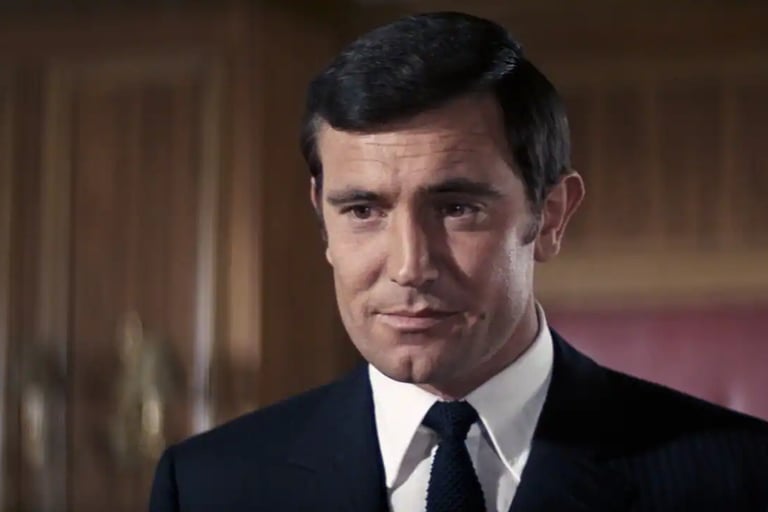

On Her Majesty’s Secret Service (1969) bothers the hell out of me. Australian male model George Lazenby was cast as Bond, with the second Avengers girl Diana Rigg as his co-star. That was a good call, because at least one of the headliners could actually act. That might not be fair, because Lazenby looked the part, but he had zero charisma in the role and came across as a block of wood who said his lines and repeatedly delivered a ridiculous uppercut in his fight scenes. No gadgets this time, and Bond drives an Aston Martin DBS, with no modifications as far as I know.
He's back after Blofeld, who somehow survived the explosion of his H.Q. which somehow reactivated the volcano making it erupt. (I’d have thought SPECTRE would’ve checked that they hadn’t sunk millions into building a fortified base with rocket launching capabilities and helicopter landing pads on an ACTIVE volcano…but there ya go!)
Blofeld is in Switzerland, on a mountaintop, where he’s planning to (again) blackmail the world, this time with a gas that will kill millions. That’s the mission – but this is Bond’s love story. Bond falls for his leading lady, and this is what annoys me about the film – it could well have been Connery’s finest moment as Bond, in a film that required an emotional performance. I would’ve loved to have seen how Connery would’ve handled the final scene, cradling his new bride’s body just after she’s been shot by Blofeld. Instead, we got the block of wood.
In 1971, Bond was back. And I mean, BOND was BACK – Connery took the role once more for, as I recall a 2 million paycheque and the backing of a couple of films of his choice. The film starts off with Bond ruthlessly pursuing Blofeld and beating the crap out of anybody who stands in his way. Presumably, this is a retaliation for killing Bond’s wife. Finally, before a resounding Shirley Bassey song, Blofeld (Charles Gray) is drowned in a mud bath.
Except of course he isn’t – he has several body doubles acting as decoys. Bond investigates a diamond smuggling ring involving Tiffany Case (Jill St John) who’s involved in getting a massive number of diamonds Blofeld needs in order to build a satellite that will emit a death ray.
This was THE film of my 1971 summer I saw it a massive eight times at the cinema, and to this day, it’s still my personal favourite of the Connery Bond movies. I loved the plot, the car chase in Las Vegas with a Ford Mustang, I came to appreciate Connery’s more laid-back delivery.
Sadly, this was not only Connery’s last official Bond film, this was also the last time we’d hear of SPECTRE or Blofeld for several years. It was time for a change.
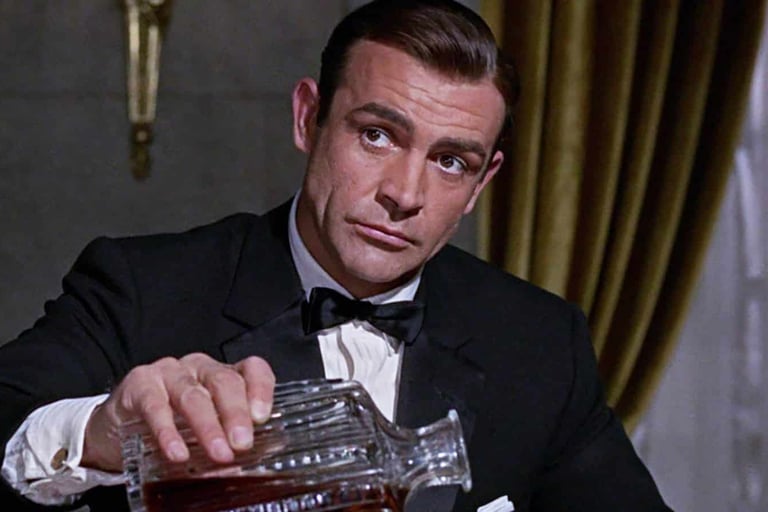

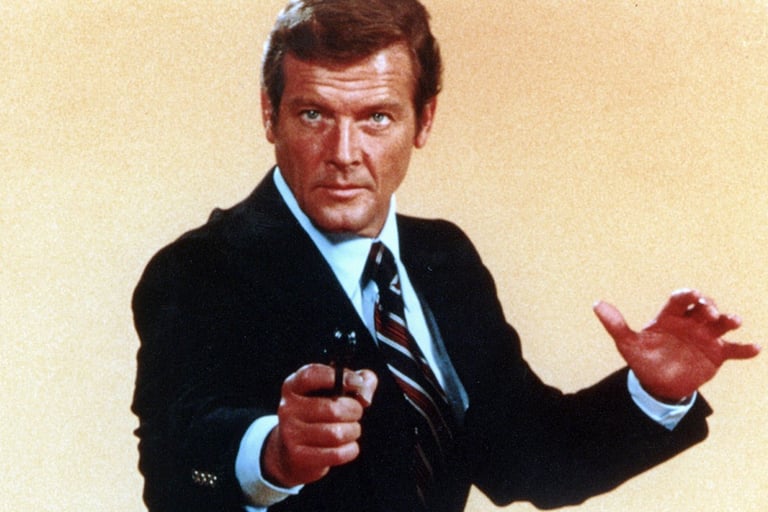

The Moore Era 1973 – 1985
I had enjoyed Roger Moore on television. The Saint was pretty much a staple on sixties TV, and in 1971, The Persuaders was one of my favourite series. But I wasn’t sure about Bond. He didn’t look like Bond. And I wasn’t sure about Paul McCartney singing the title song. For me, the whole Diamonds are Forever summer was a tough act to follow. But Live and Let Die opened, and off I went to see it.
It was unsettling, and it still is. Roger Moore is no Sean Connery. Connery had made the role his own, and Moore didn’t have his gravitas. Moore played light comedy adventure to perfection. That wasn’t Bond. What we have in Live and Let Die is a script tailored for Connery (because the producers didn’t know if he’d be back again or not) but delivered in the lighter style of Moore. So, when Moore’s Bond is threatening a woman, it’s completely out of character. Connery’s Bond was, as best I can describe it, a remorseless thug in a tuxedo. Moore’s a gentleman who doesn’t want his hair messed or his hands dirty.
The plot? Standard early seventies drugs, blaxploitation with a Bond twist. A comic relief redneck lawman, stunning stunts Jane Seymour and a voodoo element to cover up the drug ring. I loved the stunts, but I really wasn’t sure about Roger Moore in the role – and I stress, I liked Roger Moore’s other work.
So how do we fix this?
Well, the early seventies were when I started really taking an interest in horror movies. I loved the works of stars like Peter Cushing and Vincent Price, but of the active crop of horror regulars, my favourite was Christopher Lee. What better way to defibrillate the Bond series than to cast Christopher Lee as the villain? And so, we were introduced to Francisco Scaramanga, The Man with the Golden Gun, in a curiously underwhelming and half-hearted effort. Scaramanga is after Bond, and has also stolen a Solex Agitator which can solve the world’s energy crisis. When Bond becomes stranded on Scaramanga’s private island, he is challenged to a duel. (Ho hum.) Even the song by fading star Lulu was tiresome, more so when compared with a title song Alice Cooper had written and performed but wasn’t used.
In the summer of 1977, something happened. I know you might be thinking Star Wars? But no, Star Wars wouldn’t be released in the UK until Christmas. My big thing at the cinema that summer was The Spy Who Loved Me. Moore’s third outing and following my lacklustre response to Live and Let Die and Golden Gun I wasn’t expecting much. Man, I was shocked.
I had seen publicity photos in the papers of a Lotus being driven into the sea, headlong, off a pier. But in those faraway pre-internet spoiler days there was no context. Interest piqued, tickets bought, I settled on a Saturday evening with an absolutely packed house to watch the movie and was captivated from the first reel. The opening ski chase was exciting, the sky dive with the last-minute opening of the chute was simply the most daring stunt I had ever seen on screen, and I remember the whole packed cinema cheered loudly. Moore was assured in his role, with a script that was written specifically for him, unlike the previous two outings where the worst moment was his questioning of Maud Adams’ character by slapping her – something that jarred as way out of character for Moore’s gentlemanly persona.
Stromberg is the underwater obsessed villain who wants to establish his own underwater colony, ruled by him, after he’s destroyed the surface world after stealing British, American and Russian subs in a plot that’s a straight lift from You Only Live Twice, only set in the ocean, rather than space.
They got everything right in this movie, from Curt Jurgens as Stromberg to 7’2 tall Richard Kiel as henchman Jaws, complete with Titanium teeth. Barbara Bach is the most memorable and capable Bond girl in eight years as major Anya Amasova – agent XXX, Bond’s Russian counterpart. And who could resist a submersible Lotus Esprit? A passing reference to Bond’s late wife made this feel like a part of an ongoing series, acknowledging its past, which added to the satisfaction level. Carly Simon’s song Nobody Does it Better made the perfect statement.
Then, they blew it all out of the water with Moonraker!
Moonraker had the same writer, Christopher Wood, as The Spy Who Loved Me and either his success went to his head, or he suffered a sharp blow. Whereas Spy had pitched everything perfectly, Moonraker overdid every last thing, becoming nothing more, really than an increasingly tiresome series of stunts building up to a gag. Bond was a straight man in an overlong comedy skit that relied on slapstick. I remember the first time I saw the opening stunt with Bond pushed out of an aircraft with no parachute and I remember how my heart sank when that awesome build-up was sacrificed on the altar of a cheap laugh, and so it continued with a pointless gondola chase through Venice, a powerboat chase in the Amazon, Bond in the coils of an Anaconda – and finally a space battle.
The film had one saving grace in the deadpan delivery of some lines by Michael Lonsdale as Drax, but the sight Moore mugging to the audience with a small spy camera with “007” embossed on it made me groan in pain.
Not only is Moonraker still my least favourite Bond film, it’s probably close to the top of my list of the worst films I’ve seen. In the box set, it’s that film. The one I need to get through to get to the next one.
Fortunately, someone must’ve had a word with Christopher Wood because he wasn’t around for the next one – For Your Eyes Only. And it showed.
Simply put, For Your Eyes Only is a back-to-basics film, with hardly a gadget in sight. It’s a revenge movie with Moore actually acting. His leading lady, Caroline Bouquet as Melina Havelock a girl out to avenge the murder of her parents is, again, one of the best in the series. This stripping back of everything that was overdone to absurdity in Moonraker was a much-needed shot in the arm for the series. In this current re-run, I came to the conclusion, startling to me as it is, that I love everything about For Your Eyes Only from the per-title sequence involving an un-named assailant trying to kill Bond in a remote-controlled helicopter – the would-be assassin is bald, in a wheelchair, wears a neck brace and has a white cat on his lap. But we can’t call him Blofeld for the legal reasons existing at the time.
This, to me, was Moore’s finest moment as Bond – surpassing even The Spy Who Loved Me. And I wish he had called it a day and ended on a high because…
Despite the title song of Octopussy being “All Time High” the film really isn’t. The plot is confused, the circus element is more needless slapstick and I tend to lose patience with the film at around the three-quarter mark. The beginning is awesome, the Acro jet chase in Argentina, trying to outrun a heat seeking missile is pure Bond at its best. But the longer the film drags out, the more I wish it was just over – despite a fantastic performance by Steven Berkoff as a deranged war mongering Russian General.
I remember distinctly enjoying A View to a Kill in 1985, but this time around – I realised I must’ve been looking at it through rose tinted glasses. Christopher Walken, a one-note actor I’ve never really taken to, is Max Zorin, an industrialist who plans to destroy Silicon Valley to he can control the world’s microchip production. So, basically the same kind of plot as Goldfinger. He even has his own version of Oddjob in Mayday, played with robotic disdain by Grace Jones. The real problem though is Roger Moore, who at age 57 is far too old to be playing the bed hopping, athletic, indestructible super-agent. And watching his performance makes for uncomfortable viewing as he’s clearly phoning in his performance. He’s literally just reciting his lines as though he’s either bored, tired or both. I’d rate his performance here as Lazenbyesque.
Thing is, I was sad when it was announced this would be his last outing as Bond. However bad they got, and I’ve already pointed out they got BAD at times, they were comfortable summer viewing in my teens and up to my mid-twenties. In times of turbulent change in my life. Bond was a steadying comfort. They were predictable, like a pantomime. You know where you were in the movie, how close to the end, by their rigid adherence to the formula. Now that stage, that comfort was going away. The torch was passed, the era had ended.
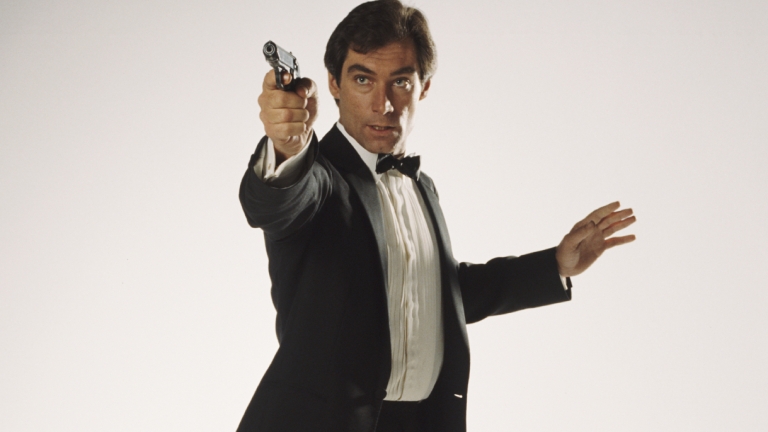

The Dalton Era (1987 – 1989)
I was pretty shocked when Dalton got the role, looking back. I wasn’t sure for some reason. The whole world seemed to be happily settled with Moore’s suave but largely non-lethal kid friendly interpretation of what is, after all, in the source material an embittered cold-blooded assassin. Dalton’s take was announced as being closer to the books. No more of Rog’s god-awful double entendres which made me wince even at the time. And time hasn’t been kind. When Dalton hit, he hit hard and took no prisoners. His Bond was indeed suave, but make no mistake – he was deadly. And The Living Daylights proved to be the perfect vehicle for this new iteration with a Soviet plan to kill spies, mixed in with a fake defection, an arms dealer and a Russian cellist, mixed in with the Russian occupation of Afghanistan which was happening at the time. It’s action packed and a completely different change of pace. I didn’t quite see it at the time, but in retrospect, it’s the shot in the arm the series needed after what seems to me now to be Moore’s over-long tenure. I used to rate Moore above Dalton until this run. Wow.
Two years later, Dalton would return in Licence to Kill, which featured one of my all-time favourite theme songs, this time by Gladys Knight. Again, there was a nail-biting pre-title sequence with Bond hanging by a winch from a helicopter, snaring a light aircraft with another winch, resulting in the short-lived capture of drug baron Sanchez (Robert Davi). It was a film where Bond turned rogue, turning in his 007 licence to infiltrate Sanchez’s organisation to kill him for the maiming of his CIA pal Felix Leiter and the murder of Leiter’s bride on her wedding night. The movie is hard hitting, but somehow wasn’t a big box office success – the summer of 1989 belonged to Batman!
Sadly, there were to be no more Dalton films. I would’ve loved to have seen him prove my Bond Rule of Three. In fact, as real-world events saw the demolishing of the Berlin Wall and the fall of Communism and the USSR, Bond’s world as it was seemed to have come to an end. We’d have to wait a few years before Bond returned.

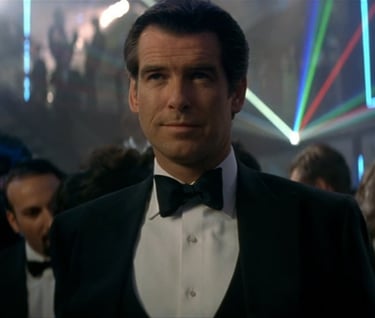
The Brosnan Era (1995 – 2002)
Pierce Brosnan was practically born to play Bond. His mixture of toughness and charm made him a mixture of Connery, Moore AND Dalton. His debut, six years after Licence to Kill, in Goldeneye showed him hit the ground running in the role. The six years we had endured without a Bond movie, having become used to a new one every other year proved to be the absence that made the heart grow fonder, with an all-new M (Judi Dench) and Moneypenny (Samantha Bond). With a younger Bond, we REALLY needed a younger Moneypenny –the sight of an increasingly elderly Lois Maxwell flirting like a schoolgirl with Roger Moore had become cringe material years earlier. Desmond Llewelyn remained as Q, but this time, the relationship with Bond was like that of an exasperated father with a mischievous son – and it worked.
If there IS a weaker link in Brosnan’s series, it might be his second movie, Tomorrow Never Dies with a news magnate who manipulates world news and events so that he can always have the exclusive scoop, and Elliot Carver (Jonathan Pryce) isn’t above starting a world war for his scoops. Thing is, Brosnan’s weakest movie is much better than the weakest of Moore or Connery’s by a long shot. I’d say it isn’t even that weak, it might be fairer to say that it’s the least strong of a stellar quartet of films.
Brosnan hit my Bond Rule of Three like a juggernaut with The World is Not Enough. Now fully confident in the role, this is the film where I believed then, as I still do, he surpassed Connery, Bond and Dalton to become my favourite actor in the role. Third time was the charm, even more than Goldfinger and The Spy Who Loved Me had been. Is there a downside? Yes – this was Desmond Llewelyn’s final appearance as Q. He had appeared in all of them since From Russia, With Love and he sadly died as this film was released, but he was given a fitting last line as he discusses retirement with Bond. “Never let them see you bleed, and always have an escape plan” as he descends through a hidden trapdoor. However, the producers had already introduced his successor, played with manic absent professor gusto by John Cleese.
Die Another Day was another triumph, despite some people’s disdain for the latest Aston Martin with an invisibility option. (I still find that more credible than Q “winterising” Dalton’s, turning a soft top into a hard top.) Bond caught by the North Koreans and tortured before the end of the pre-title sequence? This was new ground. Another megalomaniac with another satellite, another ray. But y’know, it was a fun movie as all of Brosnan’s were. My only qualm about Die Another Day is that it has possibly the worst of the Bond theme songs, with the guilty party being Madonna. It’s instantly forgettable, as is the weirdly forced in cameo she has in the film, which adds absolutely nothing. Rosamund Pike as double agent Miranda Frost though is even more memorable than Oscar winner Halle Berry as CIA agent Jinx.

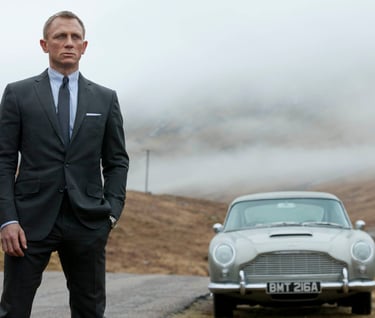
The Craig Era (2006 – 2021)
Once again, real-world events overtook the fictional world of Bond. After the events of 9/11 and the global war on terrorism, Bond was put to rest, and regrettably, Brosnan’s licence to kill was revoked. Bond would go undercover for four years and return in a film adaptation of the first Bond novel by Ian Fleming – Casino Royale. And, much as Brosnan’s Goldeneye had been, this was a reboot but retained Judi Dench as M.
Daniel Craig wasn’t the same Bond that had met the likes of Doctor No, Goldfinger, Blofeld or Scaramanga. This was said to be a prequel, showing Bond at the beginning of his career, newly promoted to the ranks of the “00” division. This was a harder hitting iteration of Bond than any we had ever seen before. And at the time, I loathed it. I wasn’t even happy with Daniel Craig in the role. There was next to nothing in the movie I liked. Not the long card game, not Bond’s romance with Vesper (Eva Green) and certainly not the ending where the film abruptly ended without the usual feelgood scene. It felt unfinished. I felt the same the first time I saw Quantum of Solace, which I just plainly didn’t understand. Until I realised that I both had and hadn’t been dropped in the middle of a film, where I had missed a few reels – Quantum of Solace was a direct continuation of Casino Royale, and Craig’s portrayal of Bond was as starkly different from Brosnan’s as Dalton has been from Moore. This was culture shock, mixed with the dawning realisation that these weren’t standalone Bond movies. These were a continuing story arc, but for how long?
As it turns out, ALL of Craig’s films are one long story arc and work far, far better when watched a week apart than with a few years between them, when details have been forgotten. I discovered that as soon as I had got the notion that these had nothing to do with any movie that had gone before, that they were their own series with a beginning, a middle end an end – they worked so much better. I would have preferred had the producers made that plan clear at the beginning, I would’ve been far more patient.
Quantum of Solace makes absolutely no sense when watched by itself, but put it between Casino and Skyfall and you have the perfect jigsaw piece. With the re-introduction of Blofeld and SPECTRE who’ve been working behind the scenes the whole time, the story gains momentum until its tragic final scenes in No Time to Die where the conclusion is hinted at broadly during the film’s opening Bond theme where Bond turns to shoot, and collapses.
Watched this way, Craig’s performance and direction of these five films as a standalone, epic story can be seen as its own entity, just as Christopher Nolan’s Dark Knight trilogy becomes its own story of the rise and fall of Batman. It tracks an entire career.
And that’s it, all the movies to date.
One last matter – I need to rate the Bonds, based on performance. This might be controversial.
Here goes
6 – George Lazenby
5 – Roger Moore
4 – Timothy Dalton
3 – Sean Connery
2 – Daniel Craig
1 – Pierce Brosnan
Have fun arguing.
